
Latrodectus mactans, known as southern black widow or simply black widow, and the shoe-button spider, is a venomous species of spider in the genus Latrodectus. The females are well known for their distinctive black and red coloring and for the fact that they will occasionally eat their mate after reproduction. The species is native to North America. The venom is rarely fatal to healthy humans.

Atypidae, also known as atypical tarantulas or purseweb spiders, is a spider family containing only three genera. They are accomplished ambush predators that spend most of their time in a sock-like, silken retreat on the ground from where they kill their prey.
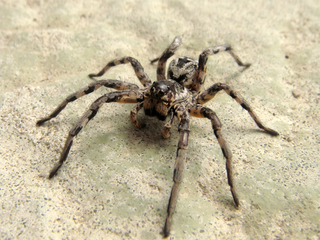
Lycosa tarantula is the species originally known as the tarantula, a name that nowadays commonly refers to spiders in another family entirely, the Theraphosidae. It now may be better called the tarantula wolf spider, being in the wolf spider family, the Lycosidae. L. tarantula is a large species found in southern Europe, especially in the Apulia region of Italy and near the city of Taranto, from which it gets its name.

The woodlouse spider is a species of spider that preys primarily upon woodlice. Other common names refer to variations on the common name of its prey, including woodlouse hunter, sowbug hunter, sowbug killer, pillbug hunter and slater spider.

The black house spider or common black spider is a common species of cribellate Australian spider, introduced to New Zealand and Japan. A closely related species, Badumna longinqua, the grey house spider, has a similar distribution, but has also been introduced to the Americas.

Drassodes is a genus of ground spiders that was first described by Niklas Westring in 1851. They are brown, gray, and red spiders that live under rocks or bark in mostly dry habitats, and are generally 3.8 to 11.6 millimetres long, but can reach up to 20 millimetres (0.79 in) in length.

Deinopis subrufa is a species of net-casting spiders. It occurs in Australia and in New Zealand. It is a nocturnal hunter, having excellent eyesight, and hunts using a silken net to capture its prey. They feed on a variety of insects – ants, beetles, crickets and other spiders. They can vary in color from fawn to pinkish brown or chocolate brown. Females are about 25 mm in body length, males about 22 mm. They are not dangerous to humans.

Larinioides sclopetarius, commonly called bridge spider or gray cross spider, is a relatively large orb-weaver spider with Holarctic distribution. These spiders are located in Europe and have been observed as south as the Mediterranean Coast and as north as Finland. They are often found on bridges, especially near light and over water. The species tends to live on steel objects and is seldom seen on vegetation. Females reach a body length of 10–14mm, and males 8–9mm. Their orb webs can have diameters of up to 70 cm.
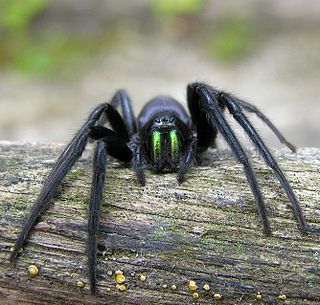
Segestria florentina is the biggest European segestriid spider. Some vernacular names are green-fanged tube web spider and cellar spider, although the latter is not exclusive to this species.
This is a list of the known wild biota of the Isle of Man.

Titanoeca quadriguttata is a species of spider in the family Titanoecidae. It is widespread in Europe, though absent from Great Britain, and is found in Austria, Belgium, Bulgaria, Corsica, Croatia, Czech Republic, France, Germany, Greece, Hungary, Italy, Liechtenstein, Moldova, Russia, Slovakia, Spain, Switzerland, the Netherlands, Ukraine.

Attulus inexpectus is a species of spider from family Salticidae, found in from Europe to central Asia. It was previously misidentified as Attulus rupicola.
Cryptocheilus notatus is the largest species of spider wasps (Pompilidae) to be found in Great Britain reaching up to 18mm in length.

Scotophaeus blackwalli, also known as the mouse spider, is a species of spider belonging to the family Gnaphosidae.

Ozyptila trux, the yellow leaflitter crab spider, is a crab spider species with Palearctic distribution.

Heliophanus cupreus, the copper sun jumper, is a species of jumping spider belonging to the family Salticidae.
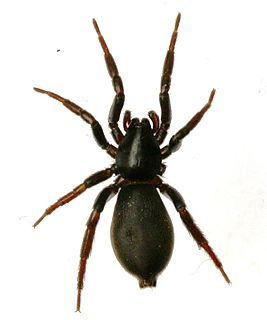
Zelotes subterraneus is a species of ground spider from the family Gnaphosidae which has a Palearctic distribution. it is the type species of the genus Zelotes. Its distribution may be somewhat masked by the difficulty of distinguishing this species from Zelotes apricorum and Zelotes latreillei.
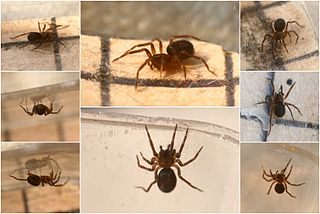
Iberina montana, the common combtailed spider, which was formerly better known as Hahnia montana, is a species of dwarf sheet spider, family Hahniidae, which is found mainly in Europe.
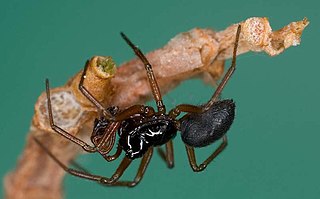
Erigone atra is a species of dwarf spider or money spider, in the family Linyphiidae. It is commonly found in North America, Europe, parts of Russia, Central Asia, China, Mongolia, Korea, and Japan. This spider is one of the most common Erigone spiders. E. atra is an important spider for agriculture, as it preys on pests such as aphids which are commonly found on crops. E. atra spiders are aeronautical spiders, as they travel via ballooning. This technique, sometimes referred to as kiting, allows E. atra spiders to traverse large distances and find new habitats when environmental or human stresses create unfit living environments. E. atra is difficult to differentiate from other congeneric species because of their similar sizes and coloring.

















